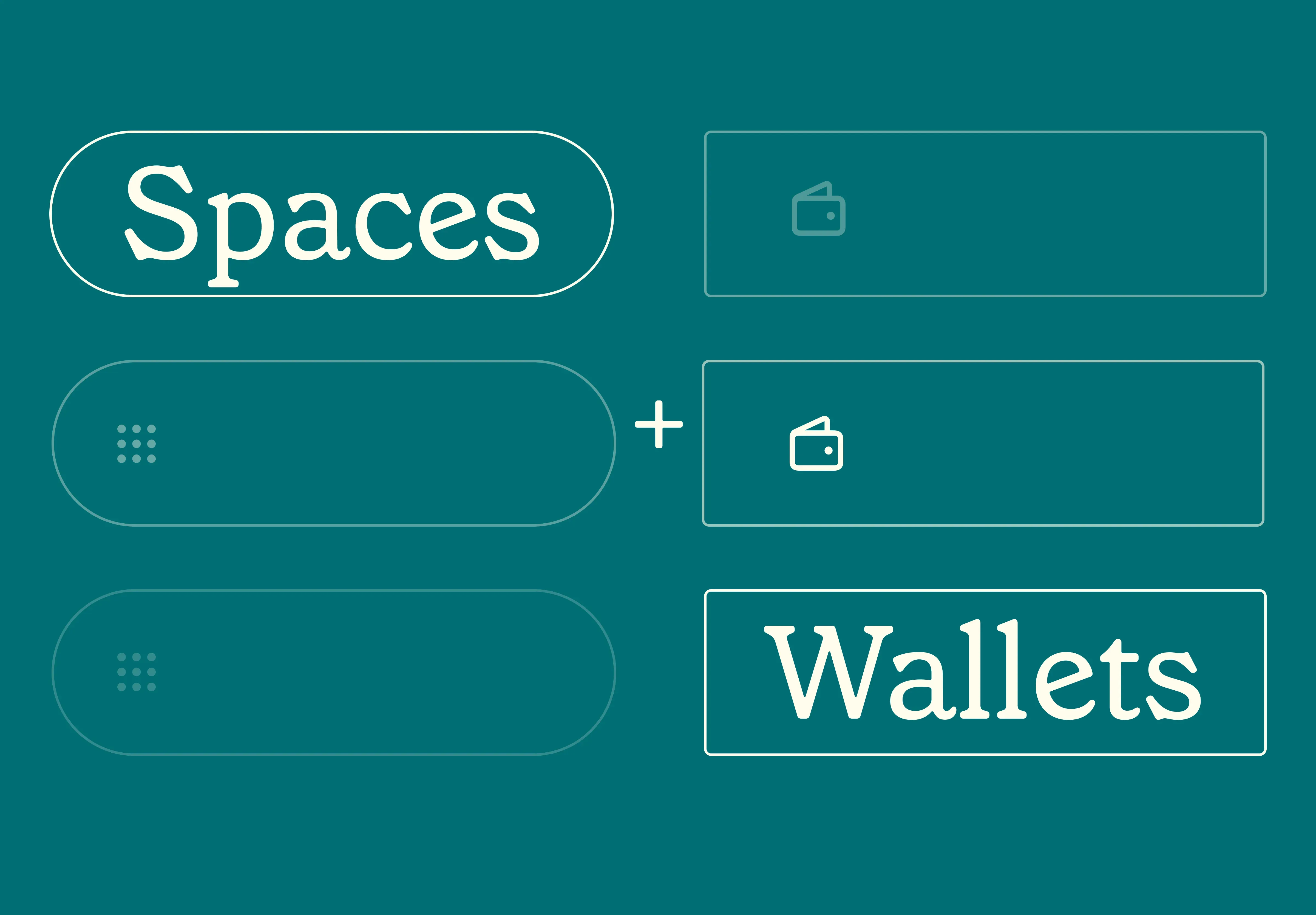14 Nov 2025
|14 min
Message testing: What it is, importance & how to conduct one
Understand message testing: what it is, why it matters, and how to conduct it effectively to refine communication and resonate with your audience.

Do you want your marketing campaign to have a big impact on your customers? Message testing can reveal your campaign’s strengths and weaknesses, helping you to optimize your efforts.
The feedback and data you gather from message testing make it possible to better tailor your marketing messaging. Whether you’re testing landing pages, websites, paid ads, email campaigns, or other types of marketing materials, message testing generates feedback about what resonates with your customers.
If you want to find better ways to boost engagement, drive conversions, and build stronger connections with your customers, message testing is essential in helping you reach your marketing goals.
In this article, we explore the importance of message testing, show you the different methods you can use and how to run messaging testing, and look at ways to analyze your results and put them into action.
What is message testing: A quick overview
Message testing is the process of evaluating how effectively your marketing messages resonate with your target audience. It helps uncover what grabs attention, what’s clear, and what inspires action. By testing different variations of your messages, you can refine your approach to ensure maximum impact and relevance for your audience.
Message testing can provide answers to important questions, such as:
Does the main headline tell people exactly what your website or content is about, and in a way that’s easy to understand?
Are calls to action (CTAs) clear and located prominently?
After scrolling through your website, do people understand your brand and the products or services you specialize in?
Does your copy effectively highlight the value and selling points of what you offer?
Are you using the right tone and voice to communicate with your target audience?
Start testing your messages
Ready to optimize your headlines, CTAs, and content? Try Lyssna and discover what resonates with your audience.
Why is message testing important?
A type of test marketing, message testing can show if an important message, like an annual sale, catches people’s attention.
You may have questions about whether your messaging will lead to conversions and engagement. Testing provides a process for collecting and measuring the effectiveness of your messaging, identifying what grabs people’s attention and what’s missing. By trying out different testing methods, you can see what type of messaging works best for your target audience.
There are several key benefits to running message testing, including:
Learning if your messaging resonates with your customers: Effective brand messaging should show the value of what you do and provide visitors with something useful.
Ensuring that your messaging makes sense: Visitors should be able to easily understand what’s being communicated and what steps they should take.
Gaining insights into what people think about your brand: Message testing can show whether your messaging leaves a positive or negative impression.
Identifying the most effective type of messaging: By trying out different variations and measuring the outcomes, you can gain an understanding of what style of messaging works best for your customers.
What marketing messages can you test?
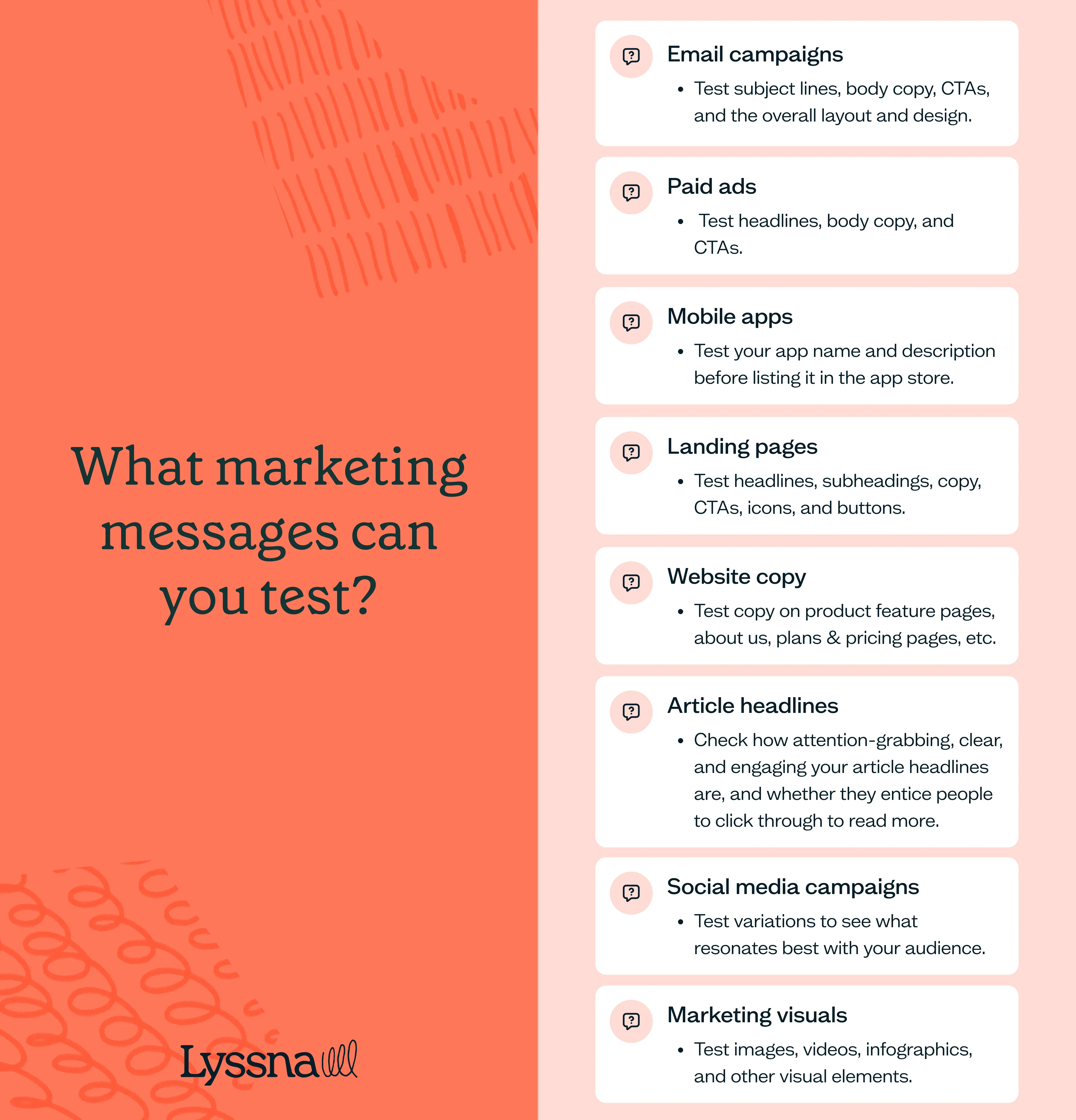
Message testing allows you to analyze all types of marketing materials and other digital content. There are a variety of things you can test – here are some ideas:
Email campaigns: Test the subject line, the body copy, calls to action, and the overall layout and design.
Paid ads: Test the messaging in your ad’s headline, body copy, and calls to action.
Mobile applications: Test your app’s name and description, and the copy used throughout.
Landing pages: Test the messaging on your website’s landing page, including headlines, subheadings, calls to action, icons, and buttons.
Website copy: Test the messaging used throughout your website, including the home page, product and services page, about us page, recruitment page, and so on.
Article headlines: Check how attention-grabbing, clear, and engaging your article headlines are, and whether they entice people to click through to read more.
Social media campaigns: Test variations of social media posts to see what resonates best with your target audience.
Marketing visuals: Test images, videos, infographics, and other visual elements to see if they effectively communicate the intended message to your target audience.
By collecting feedback from testing, you can better tailor your messaging to connect with your target audience.
Qualitative vs quantitative message testing: What’s the difference?
Message testing can provide qualitative or quantitative data, or a combination of the two. To understand the core differences between the two approaches, it helps to explore the fundamentals of quantitative research vs qualitative research. Here’s how they differ
Qualitative message testing
Qualitative testing focuses on gathering opinions and reactions from participants to understand the why behind their behaviors. It often involves a smaller sample size and offers in-depth feedback. To better understand the methods available, explore the different types of qualitative studies commonly used in message testing. Methods include:
Focus groups
Surveys and preference testing (with open-ended feedback or free-form responses)
You can analyze results from qualitative testing to identify themes and patterns, often through manual or automated processes, depending on the tools you use.
Quantitative message testing
Quantitative user testing focuses on measurable data to evaluate the what and how much of user behavior. It involves larger participant groups and delivers numerical data. Methods include:
A/B testing
Surveys (with numerical ratings)
By combining both approaches, you can gain a comprehensive understanding of what resonates with your audience and why.
Message testing examples
Marketing material | What to test | Example |
|---|---|---|
Email campaigns | Subject lines, body copy, calls to action, design layout | “Save 20% Today!” vs “Limited Time: 20% Off” |
Paid ads | Headlines, body copy, calls to action | “Sign Up Now” vs “Try for Free” |
Landing pages | Headlines, subheadings, calls to action, visuals | “Start Your Free Trial” vs “Get Started Today” |
Social media campaigns | Post captions, hashtags, visuals | Caption with humor vs a straightforward tone |
Website copy | Home page messaging, product descriptions, CTAs | Feature-driven text vs benefit-driven text |
App descriptions | Titles, descriptions, feature highlights | “Fast, Easy Booking” vs “Your Travel Companion” |
By testing variations in these areas, you can fine-tune your messaging and connect more effectively with your audience.
Message testing techniques
When testing your marketing messages, you can use several research methods to gather feedback and measure effectiveness. The method you choose depends on your goals, timeline, and the type of feedback you need. Here are the main approaches.
Surveys and questionnaires
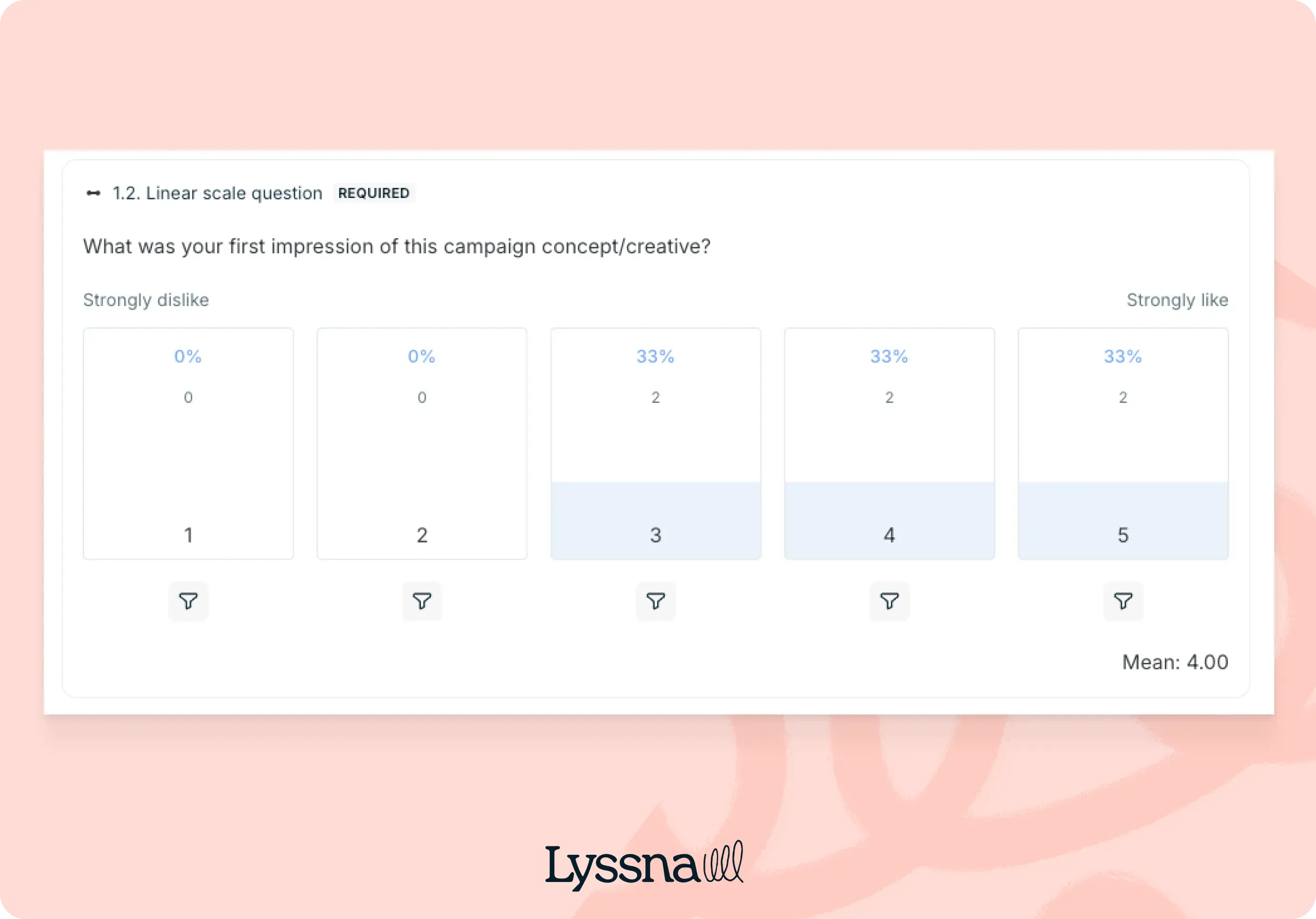
Gather structured feedback from your audience through online surveys, email questionnaires, or forms. You can collect both quantitative data (like ratings and multiple-choice responses) and qualitative feedback (through open-ended questions). Surveys are versatile – use them to test message comprehension, brand recall, or audience preferences.
Usability testing
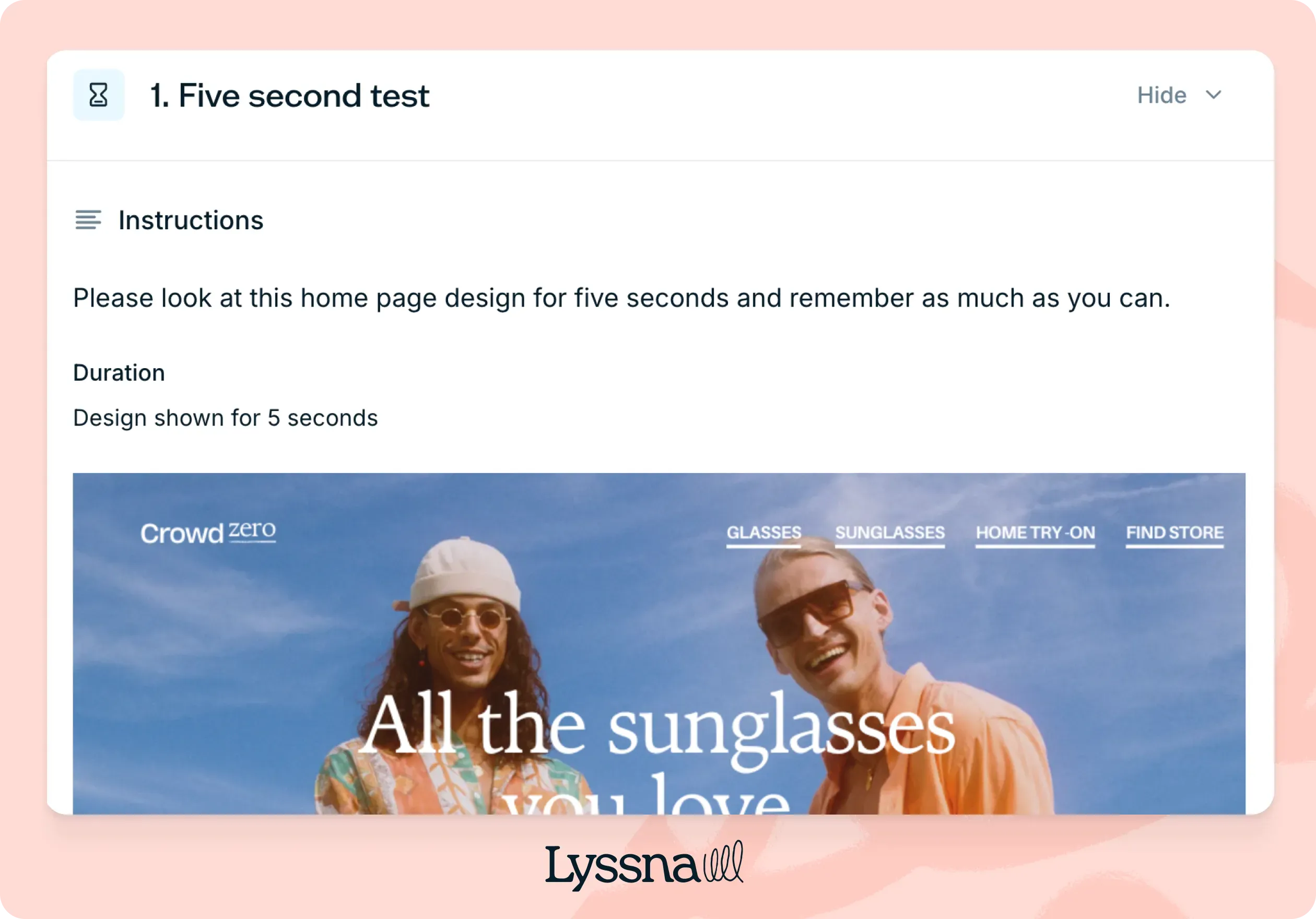
Observe how people interact with your messages in real time. This can be done through moderated remote usability testing or unmoderated sessions, where participants walk through your content while sharing their thoughts. Usability testing reveals how people actually engage with your messaging and where they might get confused. Common approaches include:
Card sorting to understand how people organize and interpret your messages.
First click testing to see what content catches attention first.
Five second testing to gauge immediate impressions of your message.
Preference testing to compare different message versions.
Interviews and focus groups
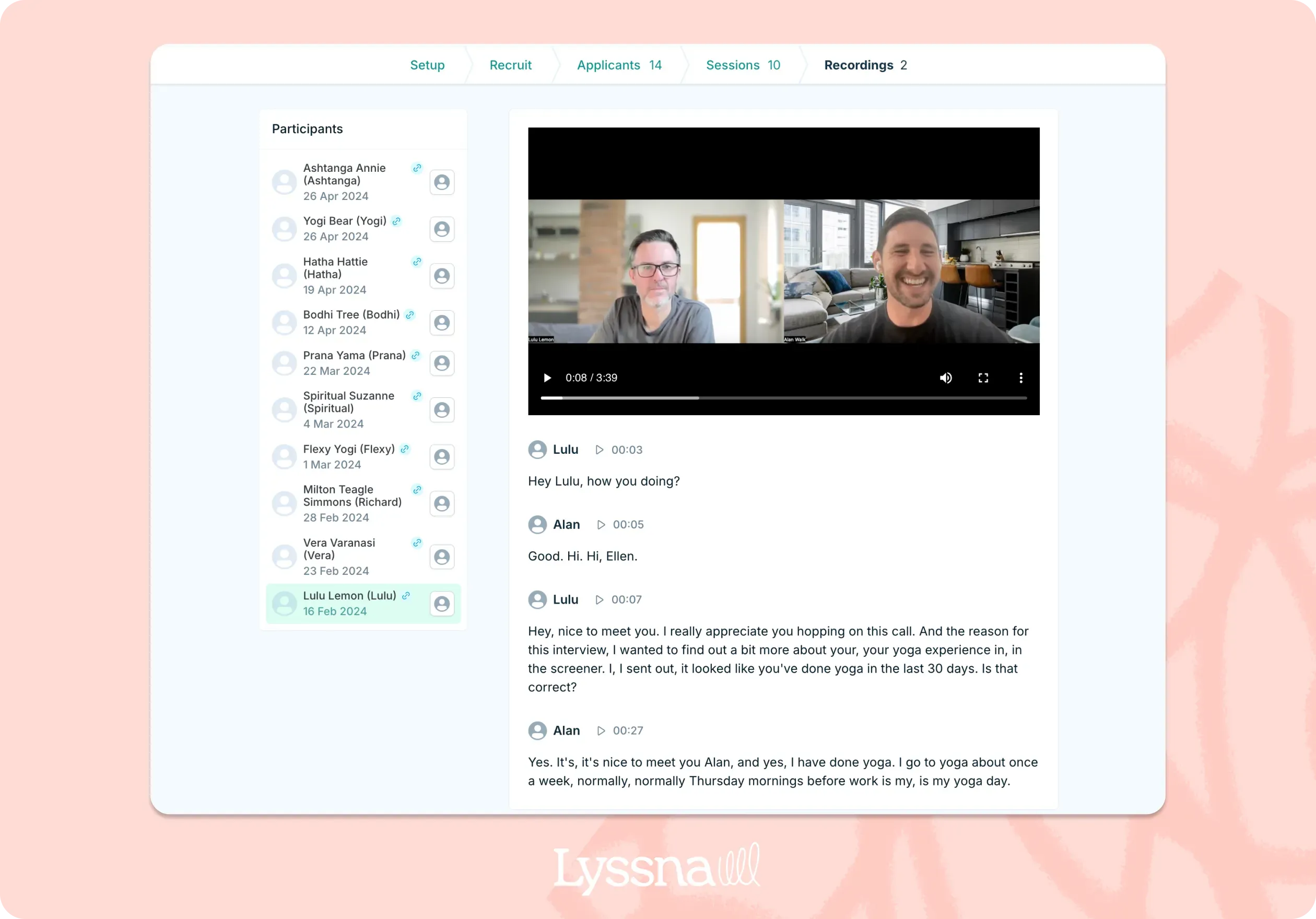
Have in-depth conversations with your target audience, either one-on-one or in small groups. These discussions provide rich qualitative feedback about how your messages are perceived and understood. Use interviews and focus groups to:
Explore reactions to different message options.
Understand how well people recall your messages.
Test if your messaging motivates people to take action.
Gather detailed feedback on tone, wording, and appeal.
Behavioral analysis
Study how people naturally interact with your messages by tracking their behavior. This method includes:
Analyzing heatmaps to see what parts of your message draw attention.
Tracking clicks to measure engagement with calls-to-action.
Reviewing analytics to understand how messages perform over time.
How to conduct message testing
Now that we’ve covered what message testing is, its benefits, and the methods you can use, let’s go through the steps you can take to conduct message testing effectively.
1. Identify your testing goals
Start by defining what you want to achieve. What messages do you want to test? What outcomes do you expect? Formulate hypotheses and develop specific questions to guide your testing.
Examples of questions to ask:
Do the directions or calls to action effectively communicate what users are supposed to do?
Is the tone and voice consistent with your brand?
Is the messaging clear and easy to understand?
2. Understand your target audience
Use tools like Google Analytics to gather demographic insights, such as age, gender, and location. Supplement this with surveys, focus groups, or other market research to gain a deeper understanding of your audience’s preferences, pain points, and expectations.
3. Choose a testing format
Select a message testing method based on your goals and the type of feedback you need. For example, use preference testing to compare variations, or first click tests to understand attention distribution.
4. Conduct message testing
Run a moderated or unmoderated user testing depending on your audience and method. Collect both qualitative and quantitative data to ensure well-rounded insights.
5. Analyze and refine
Evaluate your results, identify patterns, and refine your messaging based on feedback. Testing should be iterative – apply your learnings and continue improving.
By following these steps, you can conduct message testing and gather valuable feedback that will help you validate and optimize your marketing messaging while improving communication with your audience.
Acting on message testing results
After conducting message testing, you’ll have valuable data that you can analyze and use to improve your messaging. Here’s how to make the most of your results:
Evaluate the data and feedback: Analyze the feedback you received from participants, looking for recurring patterns and themes. These will highlight what’s working and what needs improvement.
Prioritize changes: Identify the most critical issues to address first. Focus on changes that will have the greatest impact on user engagement and conversions.
Make changes incrementally: Revise one aspect of your messaging at a time, whether it’s the wording, tone, or design. Test each change to measure its effectiveness before moving on to the next.
Continue testing and gathering feedback: Message testing isn’t a one-time task. Keep testing and iterating over time to make sure your messaging remains relevant, effective, and aligned with your audience’s needs.
Share your findings: Document your results and share them across your team. This ensures alignment, improves collaboration, and provides a reference for future testing initiatives.
By following these steps, you can leverage your message testing results to build stronger connections with your audience, refine your marketing strategy, and drive measurable success.
Message testing best practices
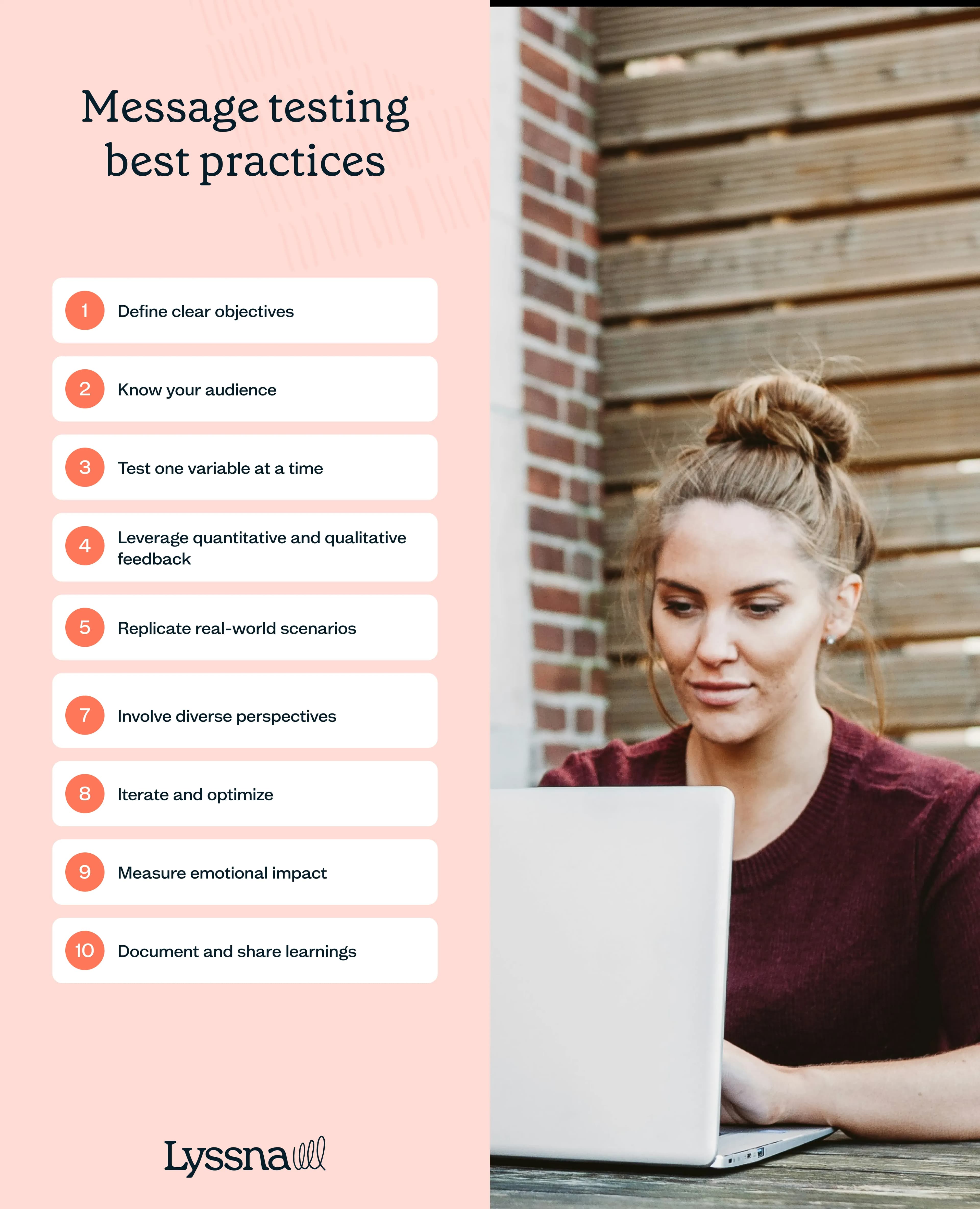
To run effective message tests that yield actionable insights, follow these recommendations.
1. Define clear objectives
Start with a precise goal. Are you testing for clarity, engagement, or conversions? Establish hypotheses, such as, "Message A will generate 20% higher click-through rates than Message B." Clear objectives keep your testing focused and measurable.
2. Know your audience
Use audience segmentation to tailor your messaging. Analyze data from tools like Google Analytics or past surveys to make sure the tone, language, and format resonate with specific demographic or psychographic profiles.
3. Test one variable at a time
Avoid muddy results by isolating variables like subject lines, calls to action, or visuals. For example, when testing email subject lines, make sure the sender name and preheader text remain consistent to isolate the subject line’s impact on open rates.
4. Leverage both quantitative and qualitative feedback
Quantitative methods (e.g. A/B testing) reveal what works, while qualitative methods (e.g. interviews) uncover why. Combining these approaches ensures a holistic understanding of your audience’s responses.
5. Replicate real-world scenarios
Conduct tests in environments that match how users engage with your messaging, such as viewing an email on a mobile device or navigating a website during peak traffic times. This increases the reliability of your results.
6. Test across channels and formats
Messaging that works in one medium (e.g. email) might fall flat elsewhere (e.g. social media). Test variations across all key platforms to ensure consistency and relevance.
7. Involve diverse perspectives
Expand beyond your usual audience segments. Diversity in age, geography, and user experience can uncover blind spots and reveal opportunities for broader appeal.
8. Iterate and optimize
Testing isn’t one-and-done. Treat it as an iterative process – refine weak messaging, retest, and adapt based on new insights. This ensures continuous improvement.
9. Measure emotional impact
Use sentiment analysis tools or focus group feedback to assess whether your messaging evokes the intended emotions, such as trust, excitement, or urgency. Messaging that resonates emotionally often drives deeper engagement.
10. Document and share learnings
Consolidate your findings into a shared knowledge base. Detail what worked, what didn’t, and why, so your team can build on these insights and save time in future campaigns.
By following these practices, you’ll create a streamlined, data-driven approach to message testing that boosts engagement, drives results, and aligns closely with your audience’s needs.
Using tools to help with message testing
The right tools can make message testing faster, more efficient, and more insightful. Lyssna offers a range of methods and techniques suitable for testing your messaging:
Five second testing: Quickly gather feedback on first impressions to see if your message resonates at a glance.
Message testing templates: Get started easily with customizable templates for testing email campaigns, website copy, and more.
Preference testing: Compare variations of headlines, calls to action, or visuals to see which drives better results.
Heatmaps and click tracking: Run first click tests to understand how users engage with your content, and identify areas that grab attention or need improvement.
Audience segmentation: Target specific demographics and psychographics to test messaging with the right participants.
Integrated qualitative and quantitative methods: Combine user interviews, surveys, and behavioral data for a complete picture of messaging performance.
Validate your message strategy
Put these message testing techniques into practice today. Sign up to Lyssna and access all our testing tools, from five second tests to preference tests. See how your audience really responds to your messaging.
Jeff Cardello is a freelance writer who loves all things tech and design. Outside of being a word nerd, he enjoys playing bass guitar, riding his bike long distances, and recently started learning about data science and how to code with Python.
You may also like these articles


Try for free today
Join over 320,000+ marketers, designers, researchers, and product leaders who use Lyssna to make data-driven decisions.
No credit card required






